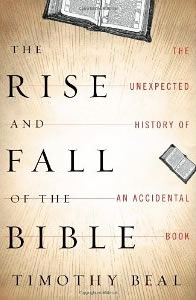Book Notes
 Timothy Beal, The Rise and Fall of the Bible; The Unexpected History of an Accidental Book (New York: Houghton Mifflin Harcourt, 2011), 244pp.
Timothy Beal, The Rise and Fall of the Bible; The Unexpected History of an Accidental Book (New York: Houghton Mifflin Harcourt, 2011), 244pp.
When Timothy Beal packed off to a Christian college after high school, a family friend gave him a copy of Harold Lindsell's book The Battle for the Bible, a manifesto which argued that authentic Christian faith depended upon the inerrancy of the Bible. Beal never read the book. In The Rise and Fall of the Bible he intersperses autobiographical story-telling with cultural theology to show how and why he arrived at "an alternative to this sort of embattled biblicism." Beal is the Florence Harkness Professor of Religion at Case Western Reserve, author of a dozen books, an active member at a Presbyterian church, and spouse of a pastor. He has long abandoned his conservative evangelical upbringing of the 1970s, but still clearly enjoys a vibrant Christian faith.
Beal begins by considering the Bible as a "cultural icon" of black-n-white religious certitude, similar to the American flag as a cultural icon of patriotism. The Bible is held in highest esteem by Christians. The average home has nine Bibles. In 2008, Bible sales totaled $823.5 million. In 2005, there were 6,134 different Bibles you could buy (34, 49). But therein lies a paradox, for Biblical illiteracy remains staggeringly high. Beal suspects this might be due to a disconnect between expectations about what one thinks is in the Bible and the experience of actually reading the Bible and discovering its content.
He then reconstructs how we got our Bible. Only 10-20% of the ancient world knew how to read. Various early texts by different authors freely floated around numerous Christian communities for different reasons. It took four hundred years for the canon to be fixed, and for what we now call "the Bible" to be collected and contained in a single book or codex, which codex was prohibitively large and expensive for widespread dissemination. The print culture of the sixteenth-century changed all that, of course, and lead to the text-critical study of the Bible by scholars like Erasmus. Before long, careful readers observed conflicting accounts about slavery or the death of Judas in Matthew and Acts, and wondered aloud about questions like divinely sanctioned violence.
Beal invokes Derrida's "wonderful phrase" about the "impoverishment of univocality," and argues instead for "polyvocality." The Bible speaks with many, conflicting voices, he says. In his view the canon is "closed" only in a loose sense of the term, and can even be thought of as "open" (188). But that's fine with him, and no obstacle to a vibrant faith. Beal is at his best when he tells his personal story; much of the historical and theological content of his book is the stuff of a good Bible introduction class. At times, though, one senses that the autobiographical overwhelms the intellectual, for there are many important and complex questions, the nuances of which are never discussed. Beal has a very particular view of the Bible that he wants to communicate, which authorial intent belies the "wonderful" notion of "polyvocality."


